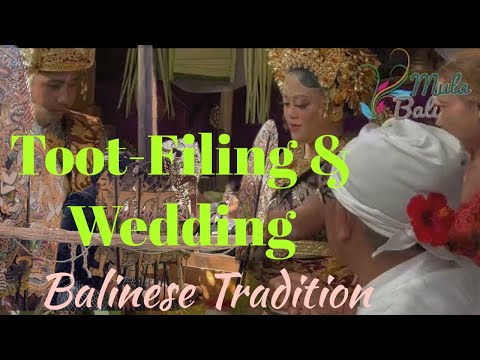Manusa Yadnya Ceremony | @Youban

Bali is always synonymous with events or ceremonies. The ceremony is part of the three basic pillars of religious life in Balinamely: Tattwa, Susila, and Upacara. Tattwa is knowledge of the philosophy of religion. Susila is the knowledge of manners or manners. The upacara is knowledge of yajna or religious ceremonies. Quoted from INDOBALINEWS, which quotes a book from Gede Rudia Adiputra, and Gusti Agung Istri Purwati, in their book Upacara and Marriage Ceremonies in Bali, "Yajna is a sacred sacrifice or offering made consciously, sincerely, and responses based on Sraddha Bhakti to God Almighty with all His creations.
Yajna carried out by Hindus is based on the belief in the existence of Three Reena, namely the Three Debts of humans in living in this world, which are divided into Dewa Reena, which is the soul's debt to God and all his blessings, through us as people if we pray diligently and pray sincerely we will pay our debts. Furthermore, Resi Reena is a debt to Resi (holy people) who have given life guidance in the form of religious knowledge, morals, character, and skills, and the last is Pitra Reena, namely debts to ancestors or parents who have died because he has given birth and raised generations. Of the three basic debts of life,.. that gave rise to Yajna as a good deed, it must also be done to Humans at birth into the world,.. which is suspected to bring fatigue or dirtiness. For this reason, in Bali,.. humans since they are still babies in the womb,
have been ceremoniously treated to be able to accept actions, as good karma in the future,..so that they always achieve success in life. From there you will see all kinds of ceremonies in Bali and that is YAJNA, namely good deeds or karma. One of the faiths or shraddha in Hinduism believed in Bali is to believe in Karma Pahala, which is the result of deeds. Because bad Karma cannot be erased
and can only be overwritten by good deeds, so doing Yajna is one of the good deeds. The ceremony in Bali, which is one of the Yajnya, has a very broad meaning. Many elements are contained in it, from the symbols used in the form of ceremony facilities there are mantras, and introductions to offerings. Also from the social aspect,.. it is very strong with the mutual assistance system, and visits so that a ceremony can be said is complete. For the ceremony held today,.the Manusa Yajna Ceremony in the form of Mepandes, or Toot Filing, and Pewiwahan or Marriage.
Why is this ceremony so important for the life of the Balinese people? It is very important because,.. in addition to being a yajna, which is intended to eliminate internal dirt,.. it also means that a human child has successfully traveled his journey as a human being,.. has passed the age of puberty, and entered a new life as a person
who has been freed by his parents to guide himself. to a more mature period of his life. Besides, parents already feel that they have paid their obligations to their children. This tooth-cutting event, generally, can be combined with the ceremony of increasing maturity and picking. The Teeth Cutting ceremony aims to reduce "Sad Ripu" from a person and as a symbol, six upper teeth and two canines are cut off. “Sad Ripu” is six innate human traits that are considered less good and are considered enemies in themselves. The six traits that are very easy to know are the nature of greed, the nature of cheating, the nature of being praised, the nature of being angry, the nature of hurting fellow creatures, and the nature of slandering.
Before carrying out the tooth-cutting process, someone carries out several processions to prepare for the ceremony. If you follow the instructions from the lontar, the stages for Mesangih begin with a ceremony called "Magumi Padangan", which is a ceremony held in the kitchen. The Balinese kitchen, which follows the Asta Kosala Kosali system, is located in the south of the yard, separated from the other buildings. The purpose of this ceremony is to rid oneself of negative energy attacks so that when you cut your teeth you are very ready physically and mentally. The next ceremony is Ngekeb, this ceremony is carried out in a room that the Balinese call "Meten" or "Gedong". This ceremony is
a ceremony performed for self-control in order to escape from the shackles of inner darkness. Before Mesangih,.. there is one more ceremony that must be followed, namely the Mabyakla ceremony. This ceremony is carried out in the courtyard as the final acknowledgment before the peak of the event, and only then is the Tooth Cutting process led by a "Sangging" the person who has the skills and license as someone who can cut teeth in this ceremony can be done.
In general,.. the tooth-cutting ceremony is carried out simultaneously, or at the same time with of wedding ceremonies, so that it can be more lively and more economical in terms of costs, although the offerings must be added to the wedding. That also happened at the manusa Yajna ceremony held by the family of the late Ni Wayan Ramyeg. There were two wedding pairs and 11 teeth-cutting participants. The time required for preparation is quite long with a series of events, especially the addition of the Sudiwedani ceremony, namely the ordination ceremony for the bride who entered Hinduism.
Our Audiences,..Thus the information that we can convey at this time, may be useful for viewers, especially those outside Bali. Thank you for watching, and do not forget to like, subscribe this channel and share.
2022-08-10 23:42


